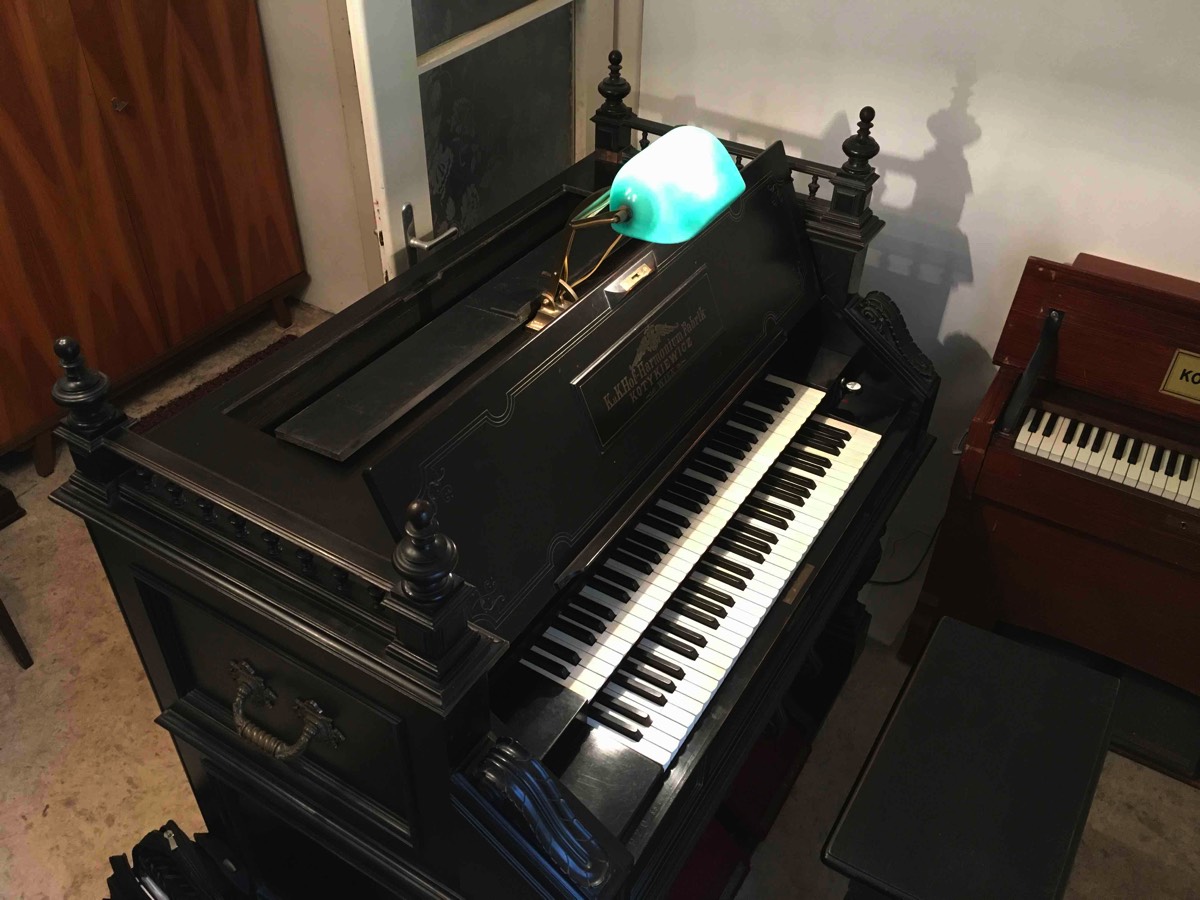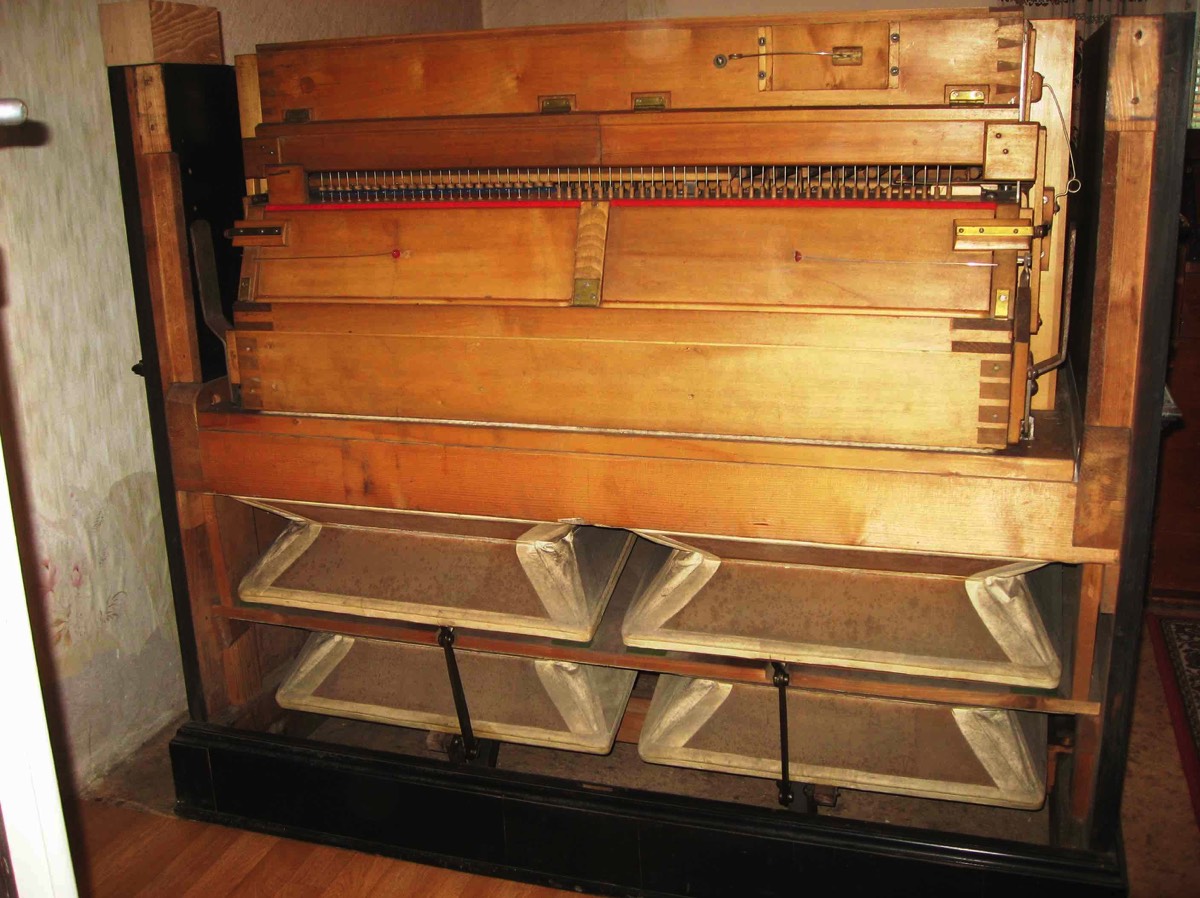Fotos: Thilo Plaesser und Dr. Alfred Kaltenecker
Das Instrument wurde am 20.09.1899 an Herrn Franz Wanecek im 11. Wiener Gemeindebezirk Simering erstausgeliefert. Es hat neuneinhalb Spiele, 2 Manuale, Percussion und Prolongement Automat. Es handelt sich um ein ganz besonderes Modell. Es gibt keinen Expressionszug, denn die Expression ist dauerhaft aktiviert! Hinzu kommt eine sehr interessante Disposition. Vier Register sind durchgehend, es gibt also keine Manualteilung: Clarinette 8´, Clairon 4´, Diapason 8´, Cello 16´. Für die Register Diapason und Cello gibt es sogar eine Oktavkoppel! Beindruckend sind die doppelt ausgelegten Schöpfbälge, die miteinander gekoppelt sind. Das bedeutet: "Wind ohne Ende".
Außerdem ist das Gehäuse sehr aufwendig gearbeitet. Sofort fällt die "Ballustrade" auf dem Instrument auf. Die Rückwand ist besonders reich verziert. Das lässt vermuten, dass das Harmonium frei im Raum gestanden hat. Normalerweise befindet sich dort ein Rückwand aus Holz oder eine Stoffbespannung. Das Harmonium ist insgesamt in einem sehr guten Originalzustand und ist im Besitz von Herrn Dr. Alfred Kaltenecker, Wien.
Forte
Clarinette 8´ durchgehend
Clairon 4´ durchgehend
Voix Celeste 8´
Violon 8´
Dolce 4´
Bourdon 16´
Cor Anglais Percussion 8´
Sourdine pour 1
Coppula Manual
Flute Percussion 8´
Clarinette 16´
Dolce 4´
Violon 8´
Voix Celeste 8´
Diapason 8´durchgehend
Cello 16´durchgehend
Baryton 32´
Forte
Coppula Octav (für Diapason und Cello)
Prolongement Automat
The instrument was first delivered to Mr. Franz Wanecek on 20.09.1899 in the 11th district of Simering in Vienna. It has nine and a half voices, 2 manuals, percussion and prologement automat. It is a very special model. There is no expression stop, because the expression is permanently activated! In addition there is a very interesting disposition. Four stops are continuous, so there is no manual division for: Clarinet 8', Clairon 4', Diapason 8', Cello 16'. For the Diapason and Cello registers there is even an octave coupler! Impressive are the double bellows, which are coupled together. This means "wind without end".
In addition, the case is very elaborately crafted. The "Ballustrade" on the instrument is immediately noticeable. The back wall is particularly richly decorated. This suggests that the harmonium stood freely in the room. Normally there is a wooden back panel or a fabric covering. The harmonium is generally in very good original condition and is owned by Dr. Alfred Kaltenecker, Vienna.
Forte
Clarinette 8´ durchgehend
Clairon 4´ durchgehend
Voix Celeste 8´
Violon 8´
Dolce 4´
Bourdon 16´
Cor Anglais Percussion 8´
Sourdine pour 1
Coppula Manual
Flute Percussion 8´
Clarinette 16´
Dolce 4´
Violon 8´
Voix Celeste 8´
Diapason 8´durchgehend
Cello 16´durchgehend
Baryton 32´
Forte
Coppula Octav (für Diapason und Cello)
Prologement Automat

































